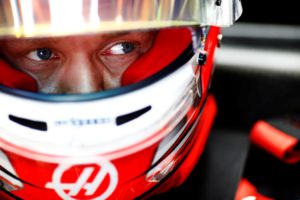Kevin Magnussen did not get any points in the latest Formula 1 Grand prix but still, he feels that his 2018 season is not bad up to now. Now the Haas driver is ready for the challenge of the Spanish Grand prix.
How much do you look forward to climbing into the race car and getting all you can out of it, as you seem to have found a level of comfort and confidence?
“I feel like I’m having a good season, so far. I’m really enjoying my time with Haas. I feel that we’re benefiting from the experience that we’ve gained together over the last year-and-a-half.”
How important is it for Haas F1 Team to put a complete race weekend together at Barcelona, where the speed its shown since testing is carried through practice, qualifying and the race so that you achieve your ultimate goal of scoring points?
“It’s always important to put your weekend together.”
When mistakes are made, are they compounded by the fact that the midfield is as competitive as it’s ever been?
“Definitely. It’s very tight in the midfield and we’re all very closely matched. Even a small mistake can be very costly in terms of positions because everyone’s so close, but it makes for exciting racing, of course. We want to be on top of the midfield as often as we can.”
Barcelona was repaved prior to preseason testing. How did the new surface rubber in as testing took place and what are your expectations for the track’s evolution during the Spanish Grand Prix?
“The new surface was very smooth. The effect on the tires was that they were difficult to get up to temperature. Also, degradation was very low, which is why Pirelli introduced a modification to the tires for this race. They’re trying to get more degradation and easier warm up on the tires.”
Family. ❤️ https://t.co/IU3Kpu2f3i
— Haas F1 Team (@HaasF1Team) May 7, 2018
How helpful is it to go back to Barcelona where Haas F1 Team has the most data of any track in Formula One simply because you spent two weeks testing there before the season even started?
“It’s always helpful to have lots of data from any track. For Barcelona, all the teams have lots of data, so it doesn’t really give us any advantage. It means that we can feel more confident in our starting setup. And then we just adjust for the track evolution since winter testing.”
Does Barcelona allow teams to reassess where they stand because of what they learned in preseason testing and how it’s translated to the first four races?
“It does give you a good idea where you stand since winter testing. In our case, we haven’t really introduced that many parts since winter testing. We had some in Australia and, of course, we can reassess that. But I think in terms of numbers and the car, we feel confident that we got the improvements we expected so far.”
 Haas F1 Team showed speed in preseason testing at Barcelona, and despite the up-and-down start to the year, it’s maintained that speed through the first four races. Does that show the strength of the Haas VF-18 and, more specifically, its adaptability as the series has visited four distinctly different circuits?
Haas F1 Team showed speed in preseason testing at Barcelona, and despite the up-and-down start to the year, it’s maintained that speed through the first four races. Does that show the strength of the Haas VF-18 and, more specifically, its adaptability as the series has visited four distinctly different circuits?
“Even though it’s been up-and-down and we’ve had some missed opportunities this year, the car performance has been consistent. At almost every race this year we’ve been fighting, not with the top-three teams, but to be the fourth or fifth team. Perhaps we were a little off in Baku, but apart from that, we’ve been able to fight to be the fourth-best team. We just need to put it all together and get the points we have the potential to achieve.”
What is your favourite part of Barcelona and why?
“My favourite part of Barcelona is the high-speed right-hander at turn nine, as it’s now flat in a Formula One car these days.”
Is there a specific portion of Barcelona that is more challenging than other aspects of the track?
“The trick in Barcelona is sector three. You’ve worked your rear tires hard throughout sectors one and two, then in sector three, that whole bit is very demanding on the rear tires. It’s kind of a traction sector. You have to take care of your rear tires a little bit in sectors one and two in order to push harder on them in sector three. That’s probably the most challenging aspect of the track.”
Explain a lap around Barcelona, especially now after having competed there with the faster, current-generation car as well as the track having new tarmac.
“Barcelona is a fast, high-speed, flowing circuit where overtaking can prove difficult.”
Do you have any milestones or moments from your junior career that you enjoyed at Barcelona?
“Yes, I won the World Series by Renault championship there. That’s always a good memory.”
“When the going gets tough, keep showing up.”
We’re ready to bounce back in Barcelona. ? pic.twitter.com/293kFi3woc
— Haas F1 Team (@HaasF1Team) May 7, 2018

































